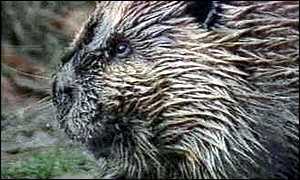
The European Beaver
By Graham Willers, May 14 th 1999
 There is so much misunderstanding regarding the potential release of the EUROPEAN Beaver ( Castor fibor NOT Castor canadensis) into Scotland. This animal is entirely vegetarian for a start and does NOT eat fish as I never cease telling the local fishermen. They rarely if ever venture more than 100 metres from the waters edge. They are 'central place' foragers and their preffered food is grasses and other herbaceous material, mainly bulrush, common reeds, quillwort, water horsetail and water lilies. It is only when this material is not available that they switch to tree bark. In this they prefer Aspen, Birch and Rowan but will take Willows and
Alder if pushed. Debarking of Conifers is very rare. They will take Scots Pine bark very occasionally and they don't - to the best of my knowledge - touch Sitka Spruce (main commercial species in Scotland). The maximum diameter of any shrub or tree stem they can eat is about 8mm.
There is so much misunderstanding regarding the potential release of the EUROPEAN Beaver ( Castor fibor NOT Castor canadensis) into Scotland. This animal is entirely vegetarian for a start and does NOT eat fish as I never cease telling the local fishermen. They rarely if ever venture more than 100 metres from the waters edge. They are 'central place' foragers and their preffered food is grasses and other herbaceous material, mainly bulrush, common reeds, quillwort, water horsetail and water lilies. It is only when this material is not available that they switch to tree bark. In this they prefer Aspen, Birch and Rowan but will take Willows and
Alder if pushed. Debarking of Conifers is very rare. They will take Scots Pine bark very occasionally and they don't - to the best of my knowledge - touch Sitka Spruce (main commercial species in Scotland). The maximum diameter of any shrub or tree stem they can eat is about 8mm.
The felling of trees for dam-building is most likely the aspect that worries people. The dams are built to keep the water level above the burrow entrance. If the water does not naturally fall below the desired depth then they will not build one. Simple as that. For example in a Lapland reserve they built dams in only 18.7% of sites and the preffered diameter of stems is only 1.5 to 3.5 cm.
It has been an indigenous species for over 12 million years in Europe and was definately present in Scotland until the 12 th century and almost certainly until the 16 th century and its demise was due in large part to its valuable pelt which was a Scottish export at that time. This is not really the place to go into an in depth article but I hope you will take my word for it that after extensive research by Scottish Natural Heritage the conclusion was that the reintroduction of Beaver would result in negligable damage to trees and the benefits - especially to water courses and fishing - far outweigh any disadvantages. This is mainly due to the fact that the small number of ponds they create act as sediment traps, moderate flooding, help to neutalise acid run-off, provide extra food for invertebrates and fish ( via the trapping of organic matter) and create additional habitat for other creatures.
They have been introduced into 87 locations in Europe since 1920 and 53% of these introductions have been successfull. Also we ( The UK ) have a legal obligation to investigate the possibility of reintroduction of species under Article 22 of the EU Directive on conservation of Habitats - The so-called 'Habitats Directive'. This covers the 'liste' species on 'Annex 4' of which the 'keystone' species of Castor fibor is one. Quite apart form the legal obligation (IMO) we have a moral obligation to do so.
The financial returns that would result from greatly increased tourism revenues is another reason we need them in 'fragile environments' - I think you will find the the definition of 'environment ' also includes the people who live in it and the socio-economic factors involved. The experince in Poland is a marked net benefit to the local economy following their reintroduction. In these days of falling margins in forestry and the increased need to conserve biodiversity the Beaver is a perfect example of environmentaly sound diversification for profit.
14 th May 1999
 |
 |
 |
| Return to index | Return to Exotic Scottish Animals | Return to European Beaver |